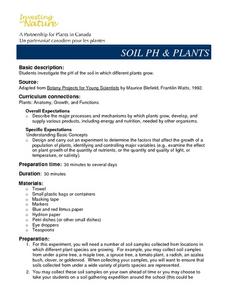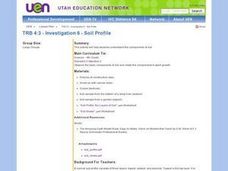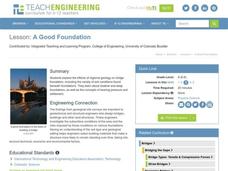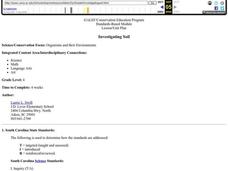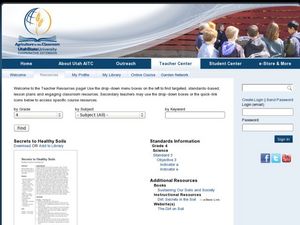University of Southern California
What Is The Ocean?
Go on a tour of the ocean through the lens of a scientist. Learners read maps of the ocean floor, study tide behavior, examine wave motion, and analyze components of soil. Each lesson incorporates a hands-on component.
Kenan Fellows
Terrarium in a Bottle: Modeling the Atmosphere, Greenhouse Effect, and Water Cycle
You've heard of farm to table ... but what about farm in classroom? Junior agriculturalists embark upon a two-week journey into the science of growing things. Based upon the classic terrarium in a two-liter experiment, the instructional...
Marine Institute
Water Pollution
Sixth graders investigate the various types of pollutants found in water and ways to help prevent water pollution. Through a hands-on experiment, students create samples of polluted water by mixing water with vegetable oil, dirt, and...
Curated OER
Rocks and Soil Changes lesson plan
Students recognize objects around their school made of rocky materials. In this changes in rocks and soil activity, students use a website for a virtual experiment of rocks. Students group rocks based on their properties. Students...
Curated OER
What Do Soils Have to Do With Me?
In this identifying ways we use soils every day worksheet, students investigate their houses, home environment, clothing labels, and foods to see what was made from things grown in soils. Students write 5 short answers.
Curated OER
Terrestrial Ecosystem Response to Climate Change
An extensive investigation of the Earth's climate changes awaits your environmental science classes. This top-notch presentation begins by looking at the history of Earth's climate and then predicts the impact on each major terrestrial...
Curated OER
Plant Reproduction
In this plant reproduction worksheet, students follow the steps to complete a science investigation and then respond to 2 short answer questions and complete a data table regarding the investigation.
Curated OER
Selecting Soil For a Sports Field
In this science worksheet, students take part in a laboratory exploration looking at different types of soil. The soil is evaluated in order to fill the role of becoming a sports field.
Curated OER
Decomposition, Soil, and Life Cycle Research
Students conduct background research on the decomposition process, soil composition, and the life cycle using the resources provided for Internet searches. They work in collaborative groups to research topics as a particular plant, soil...
Curated OER
How Can You Test Your Soil?
Learners investigate chemicals in soil samples. In this soil science lesson, students test local soil to measure the pH, nitrate, phosphate, and potassium content.
Curated OER
Observing and Questioning
Third graders investigate different types of soil. In this soil lesson, 3rd graders compare various soil samples. They work hands-on with their peers to find the differences and similarities.
Curated OER
Investigating Animals in Soil
Students investigate and observe small animal activity on a plot of land on their school grounds. In small groups they identify the five kingdoms of animals, stake out a small plot of ground, collect samples, record and analyze any data...
Curated OER
SCRUMPTIOUS SOIL
Learners engage in investigations that lead to the discovery that earth materials consist of rocks, soils, water, and air. They build models of soil profiles, using breakfast cereal and other edible materials. They observe how water...
Curated OER
Science in the Garden
Students examine soil from their local environment. For this garden lesson, students recognize the importance of soil in the garden. Students explore the contents of the local soil.
Curated OER
Soil pH & Plants
Students investigate the pH of the soil in which different plants grow. They design and carry out an experiment to determine the factors that affect the growth of a population of plants, identifying and controlling major variables...
Curated OER
Investigation 6 - Soil Profile
Fourth graders study the components of soil. They observe the basic components of soil and relate the components to plant growth. They record color, texture, and kinds of materials on their profile log (light color, denser, grittier -...
Curated OER
Investigation 3 - Weathering
Fourth graders study 4 types of weather processes: wind, running water, plant growth, and freezing water. They explain how the processes of weathering and erosion change and move materials that become soil. They draw diagrams...
Curated OER
Glacial Striation Investigation
Students operate a GPS unit to investigate the direction of glacier movement. They describe the motion of glacier movement by interpreting a graph. Students explain how scientists use glacier striations to determine glacier movement.
Curated OER
Just Passing Through
Students explore how water moves through soil. They experiment with different soil types and record their findings.
Teach Engineering
A Good Foundation
It takes a strong foundation to build a house and a stronger one for a bridge. This resource presents the effects of geology and soil on bridge foundations. Working in groups, the class investigates the interaction of shallow and deep...
Curated OER
WET Science Lesson #3: Comparison of Aquatic and Terrestrial Plants
Elementary life science explorers compare and contrast aquatic and terrestrial plants (elodea and soybeans) in a Venn diagram. Some background information is provided to support direct instruction, and general instructions are provided...
Curated OER
Investigating Soil
Fourth graders swap local soil samples with another school and examine the differences. They research soil properties, identify organisms that live in soil, create and maintain a biome of soil decomposition and design a poster to present...
Curated OER
Soil Formation
Seventh graders investigate how soil is formed. They analyze types of soil samples, examine soil using a magnifying glass or microscope, complete a chart, conduct a soil and plant experiment, and construct a soil profile.
Curated OER
Secrets to Healthy Soil
Fourth graders explore needed mineral nutrients for healthy soil. In this soil lesson, 4th graders investigate how living and nonliving elements combine to contribute to fertile soil development.
















